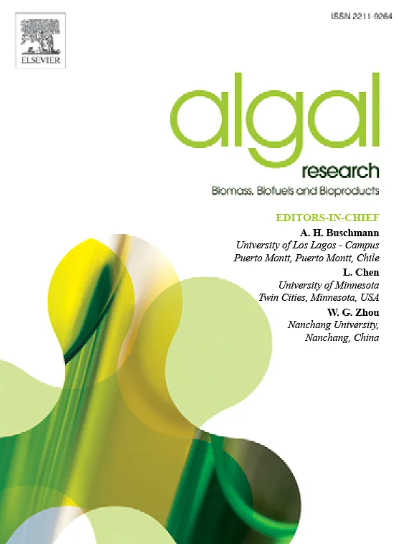Synergistic effects during co-pyrolysis of microalgal residues and municipal sewage sludge in an H2-containing atmosphere: Pyrolysis characteristic and kinetics
IF 4.6
2区 生物学
Q1 BIOTECHNOLOGY & APPLIED MICROBIOLOGY
Algal Research-Biomass Biofuels and Bioproducts
Pub Date : 2025-03-18
DOI:10.1016/j.algal.2025.104013
引用次数: 0
Abstract
In this study, the co-pyrolysis kinetics of municipal sewage sludge (MSS) and Chlorella vulgaris (MCV) in hydrogen atmosphere was studied by thermogravimetric analyzer. Three dynamic models (Friedman, Flynn-Wall-Ozawa and Kissinger-Akahira-Sunose) and DAEM (a model fitting method) were used to accurately fit the experimental data at three heating rates (10, 30 and 50 °C/min). Their physical and chemical properties indicate that they have potential for energy recycling and fuel production. The kinetic model parameters are fitted successfully at different heating rates, and the linear fitting curve of DAEM is within the expectation. The kinetic curve fitting results show that the activation energy changes with the conversion rate, which is directly related to the complexity of molecular chain breaks during pyrolysis. When the proportion of MCV is 20 % (MSS80MCV20), the average activation energy of pyrolysis at 50 % conversion is the lowest, no more than 100 KJ/mol. This data is significantly lower than the average activation energies of the other three samples, which are 179 KJ/mol, 325 KJ/mol and 260 KJ/mol. This study confirmed that the mixed pyrolysis of MSS and MCV in hydrogen atmosphere can significantly change the activation energy Eα of the reaction, which can provide basic data support for the reaction operation conditions of the pyrolysis unit.

求助全文
约1分钟内获得全文
求助全文
来源期刊

Algal Research-Biomass Biofuels and Bioproducts
BIOTECHNOLOGY & APPLIED MICROBIOLOGY-
CiteScore
9.40
自引率
7.80%
发文量
332
期刊介绍:
Algal Research is an international phycology journal covering all areas of emerging technologies in algae biology, biomass production, cultivation, harvesting, extraction, bioproducts, biorefinery, engineering, and econometrics. Algae is defined to include cyanobacteria, microalgae, and protists and symbionts of interest in biotechnology. The journal publishes original research and reviews for the following scope: algal biology, including but not exclusive to: phylogeny, biodiversity, molecular traits, metabolic regulation, and genetic engineering, algal cultivation, e.g. phototrophic systems, heterotrophic systems, and mixotrophic systems, algal harvesting and extraction systems, biotechnology to convert algal biomass and components into biofuels and bioproducts, e.g., nutraceuticals, pharmaceuticals, animal feed, plastics, etc. algal products and their economic assessment
 求助内容:
求助内容: 应助结果提醒方式:
应助结果提醒方式:


